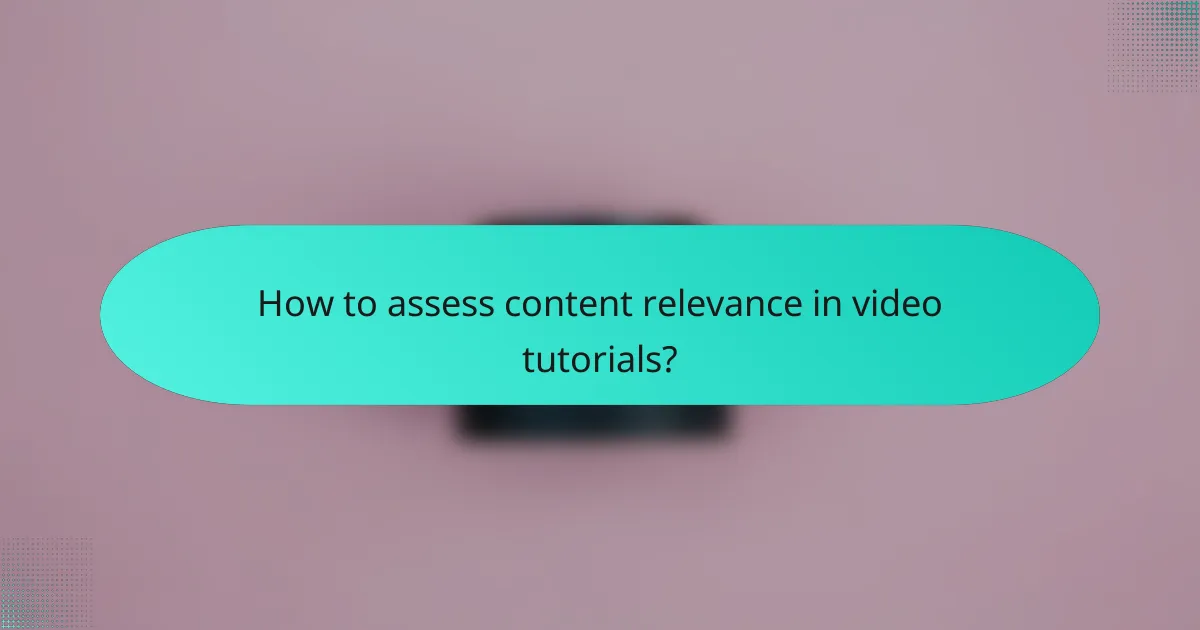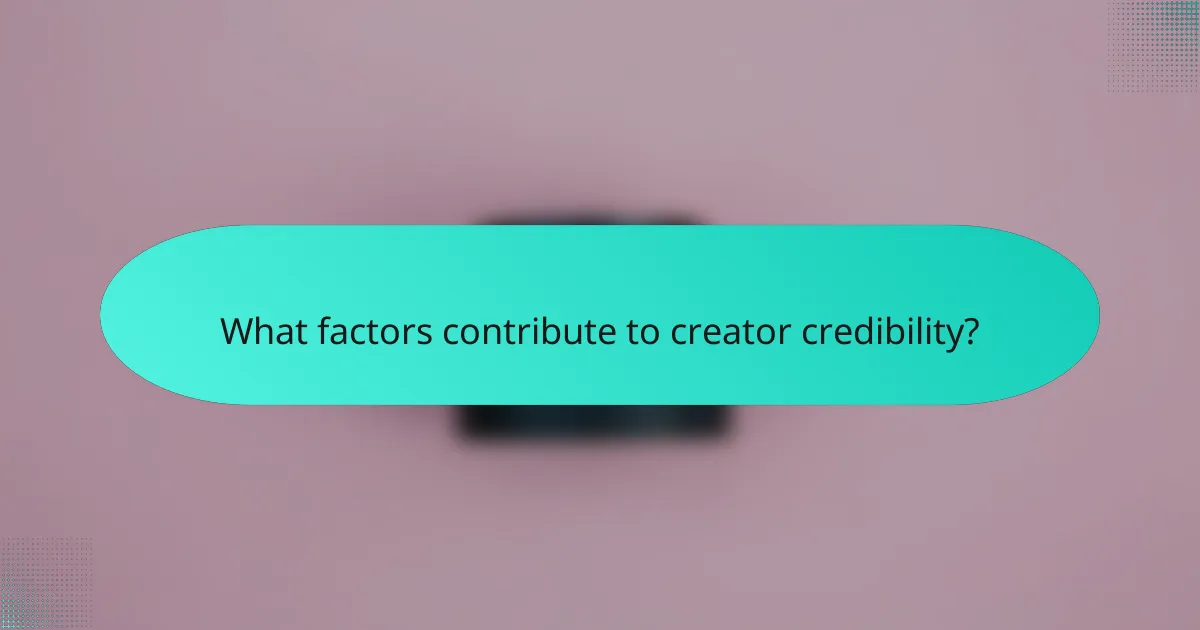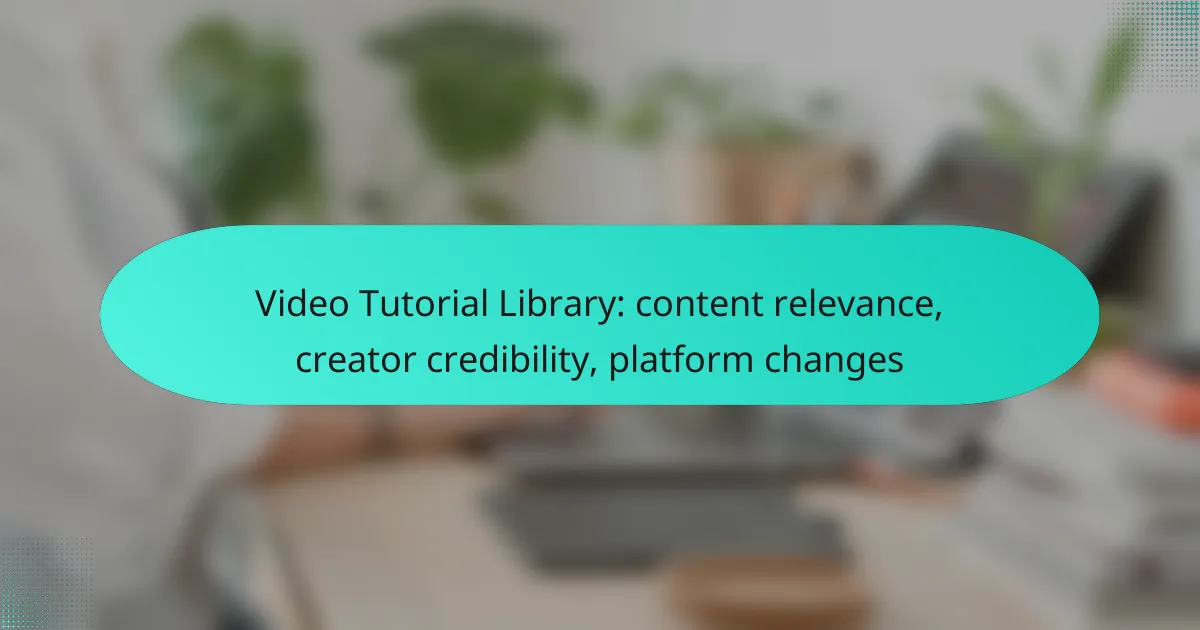In today’s digital landscape, evaluating video tutorials requires a keen understanding of content relevance, creator credibility, and the impact of platform changes. Assessing how well tutorials meet audience needs and the trustworthiness of their creators is essential for effective learning. Additionally, shifts in platform algorithms and policies can greatly influence the accessibility and discoverability of valuable educational content.

How to assess content relevance in video tutorials?
Assessing content relevance in video tutorials involves evaluating how well the material meets the needs and expectations of the target audience. Key factors include user engagement, alignment with user needs, and effective SEO strategies.
User engagement metrics
User engagement metrics are critical indicators of how well a video tutorial resonates with its audience. Metrics such as watch time, likes, shares, and comments provide insights into viewer interest and satisfaction. High engagement often correlates with relevant content that addresses user queries effectively.
To assess these metrics, consider using analytics tools provided by platforms like YouTube or Vimeo. Look for trends over time; for instance, a steady increase in watch time suggests growing relevance. Aim for engagement rates above industry averages, which typically hover around 5-10% for educational content.
Content alignment with user needs
Content alignment with user needs ensures that the tutorial addresses specific questions or problems faced by the audience. Start by researching common queries in your niche through forums, social media, or keyword tools. This helps in creating tutorials that are directly relevant to users’ interests.
Consider conducting surveys or polls to gather direct feedback from viewers about what topics they find most useful. Tailoring content based on this feedback can significantly enhance relevance and user satisfaction. Regularly updating tutorials to reflect changes in user needs is also essential.
SEO optimization strategies
SEO optimization strategies help improve the visibility of video tutorials in search results, making them more accessible to users. Start by incorporating relevant keywords in the title, description, and tags. This ensures that the content appears in searches related to the tutorial topic.
Additionally, consider creating engaging thumbnails and using closed captions to enhance accessibility and improve rankings. Regularly analyzing performance through SEO tools can help identify areas for improvement. Aim for a balance between keyword optimization and natural language to maintain viewer engagement.

What factors contribute to creator credibility?
Creator credibility is influenced by several key factors, including their expertise, audience feedback, and the consistency of their content quality. These elements help viewers assess whether a creator can be trusted to provide valuable and accurate information.
Expertise and qualifications
Creators with relevant expertise and qualifications tend to be viewed as more credible. This can include formal education, professional experience, or specialized training in the subject matter they cover. For example, a fitness instructor with a degree in exercise science may be more trusted than one without formal training.
Additionally, showcasing certifications or awards can further enhance a creator’s credibility. Viewers often look for indicators that a creator has a solid foundation in their field, which can significantly impact their trustworthiness.
Audience feedback and reviews
Audience feedback, including comments and reviews, plays a crucial role in establishing a creator’s credibility. Positive testimonials and high engagement levels can signal to new viewers that the creator is reliable and respected within their niche. For instance, a video tutorial with numerous likes and positive comments is likely to attract more viewers.
Conversely, negative feedback or a lack of engagement can raise red flags. Creators should actively encourage and respond to audience feedback to build a trustworthy reputation and address any concerns that may arise.
Consistency in content quality
Consistency in content quality is vital for maintaining creator credibility. Regularly producing high-quality videos that meet viewer expectations helps build trust over time. Creators should aim for a consistent style, format, and level of detail in their tutorials to keep audiences engaged.
Moreover, creators should avoid drastic changes in content direction or quality, as this can confuse or alienate their audience. Establishing a reliable schedule for content release can also enhance credibility, as viewers come to expect new material at regular intervals.

How do platform changes affect video tutorial accessibility?
Platform changes can significantly impact the accessibility of video tutorials by altering how content is discovered and monetized. Updates to algorithms, monetization policies, and new features can either enhance or restrict user access to educational materials.
Algorithm updates on YouTube
YouTube’s algorithm updates can shift which videos are recommended to users, affecting the visibility of tutorial content. For creators, this means adapting to changes in ranking factors, such as viewer engagement and watch time, to maintain or improve their reach.
To stay relevant, creators should focus on producing high-quality, engaging content that encourages viewer interaction. Regularly analyzing performance metrics can help identify trends and adjust strategies accordingly.
Changes in monetization policies
Monetization policy changes can influence the financial viability of creating video tutorials. For instance, stricter eligibility criteria for ad revenue can limit income for smaller creators, potentially reducing the quantity and quality of educational content available.
Creators should explore alternative revenue streams, such as sponsorships, merchandise, or crowdfunding, to supplement their income. Understanding the latest policies can help them navigate these changes effectively.
Impact of new features on user experience
New features introduced by platforms like YouTube can enhance user experience by making tutorials more interactive and engaging. Features such as chapters, polls, and live Q&A sessions can facilitate better learning outcomes and keep viewers engaged.
Creators should leverage these features to improve accessibility and retention. However, they should also be mindful of potential technical issues that may arise with new tools, ensuring that their content remains user-friendly and accessible across devices.

What are the best practices for video tutorial creation?
Effective video tutorial creation involves clear instructional design, high production quality, and an engaging presentation style. These elements ensure that the content is not only informative but also enjoyable for viewers, leading to better learning outcomes.
Clear instructional design
Clear instructional design is essential for creating video tutorials that effectively convey information. Start by defining the learning objectives and structuring the content logically, breaking complex topics into manageable segments. This helps viewers follow along and retain information more easily.
Consider using visual aids, such as slides or graphics, to reinforce key points. A well-organized outline can guide the viewer through the tutorial, ensuring that each section builds on the previous one. Remember to include summaries or key takeaways at the end of each segment to reinforce learning.
High production quality
High production quality enhances the viewer’s experience and credibility of the tutorial. Invest in good lighting, clear audio, and a stable camera setup to ensure that the content is visually appealing and easy to understand. Poor production quality can distract viewers and diminish their engagement.
Editing is also crucial; use editing software to cut out unnecessary parts, add transitions, and incorporate graphics or text overlays. Aim for a polished final product that reflects professionalism, as this can significantly impact the perceived value of the tutorial.
Engaging presentation style
An engaging presentation style keeps viewers interested and motivated to learn. Use a conversational tone and vary your vocal delivery to maintain attention. Incorporate storytelling techniques or real-life examples to make the content relatable and memorable.
Encourage viewer interaction by asking questions or prompting them to reflect on the material. This can be done through comments or polls if the platform allows. Avoid monotony by using different camera angles or including guest speakers to provide diverse perspectives.

How to choose the right platform for video tutorials?
Choosing the right platform for video tutorials involves evaluating factors such as content relevance, creator credibility, and platform features. Consider your target audience, the type of content you want to produce, and how you plan to monetize your efforts.
Comparison of YouTube vs Vimeo
YouTube and Vimeo are two of the most popular platforms for video tutorials, each with distinct advantages. YouTube offers a vast audience and robust search capabilities, making it easier to reach a larger viewer base. In contrast, Vimeo is known for its high-quality video playback and professional community, appealing to creators focused on aesthetics.
When comparing features, YouTube provides extensive analytics and monetization options through ads, while Vimeo offers subscription-based models with advanced privacy settings. Depending on your goals, one platform may suit your needs better than the other.
Platform audience demographics
YouTube has a diverse audience spanning various age groups, with a significant portion of users aged 18 to 34. This broad demographic makes it an ideal choice for content creators targeting younger viewers. On the other hand, Vimeo tends to attract a more niche audience, often comprising professionals in creative industries such as film, design, and photography.
Understanding the demographics of each platform can help you tailor your content effectively. If your tutorials cater to a creative professional audience, Vimeo may provide a more engaged viewership.
Monetization options available
YouTube offers multiple monetization options, including ad revenue, channel memberships, and Super Chat during live streams. Creators can earn income based on views and engagement, making it a lucrative choice for those who can generate significant traffic.
Vimeo, however, focuses on subscription-based revenue models, allowing creators to charge for access to their content. This can be beneficial for tutorial creators who want to offer exclusive content and build a loyal subscriber base.
